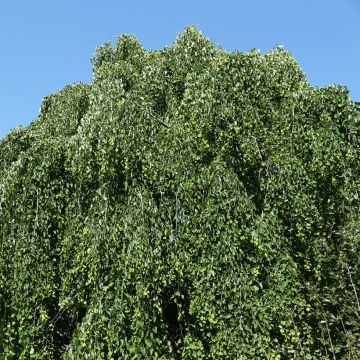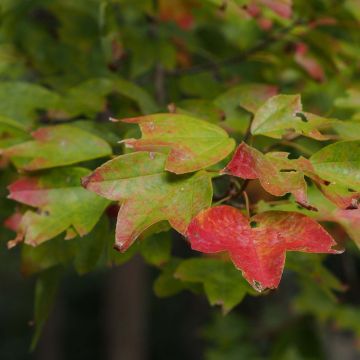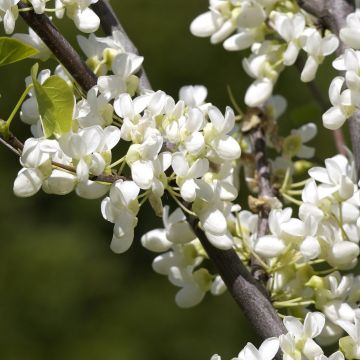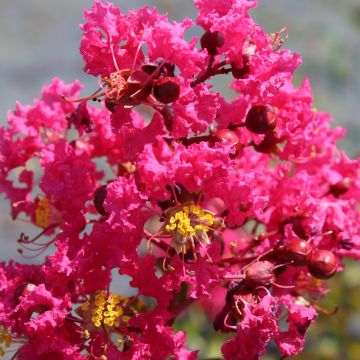

Cercidiphyllum japonicum Glowball - Arbre à caramel


Cercidiphyllum japonicum Glowball - Arbre à caramel
Cercidiphyllum japonicum Glowball
Cercidiphyllum japonicum Glowball
Katsura tree, Japanese Judas tree
I planted a young plant, about thirty years ago, in the spring, and now it perfumes the entrance of my garden, with a very strong and pleasant scent of 'cotton candy'. Furthermore, it is a small developing tree, with no specific requirements.
jean-rené, 09/10/2022
Special offer!
Receive a €20 voucher for any order over €90 (excluding delivery costs, credit notes, and plastic-free options)!
1- Add your favorite plants to your cart.
2- Once you have reached €90, confirm your order (you can even choose the delivery date!).
3- As soon as your order is shipped, you will receive an email containing your voucher code, valid for 3 months (90 days).
Your voucher is unique and can only be used once, for any order with a minimum value of €20, excluding delivery costs.
Can be combined with other current offers, non-divisible and non-refundable.
Why not try an alternative variety in stock?
View all →This plant carries a 24 months recovery warranty
More information
We guarantee the quality of our plants for a full growing cycle, and will replace at our expense any plant that fails to recover under normal climatic and planting conditions.
Would this plant suit my garden?
Set up your Plantfit profile →
Description
Cercidiphyllum japonicum 'Glowball' is an interesting selection of bush known for its more compact habit and moderate growth, well suited to small gardens. This deciduous bush offers decorative young shoots that are red in colour, bluish-green foliage in summer, and beautiful golden to orange colours in autumn. Just like the classic caramel tree, its leaves emit a light and sweet fragrance when stepped on.
The Cercidiphyllum japonicum is the only species in the Cercidiphyllaceae family, which is dedicated to it. This fast-growing deciduous tree, native to China and Japan, has become rare in its original habitat but is widely cultivated in western parks and gardens. When left to grow freely, it tends to grow with multiple trunks, each forming a narrow fork, with short branches spreading horizontally in a cascade. The overall habit is rather slender, conical, but quite wide. While this tree can reach 30 or even 45 metres (147 feet 7 inches) in its native habitat, making it one of the tallest in the forest, it rarely exceeds 12 to 15 meters (39 feet 5 inches to 49 feet 2 inches) in height in our climate, with a spread of 6 to 8 metres (19 feet 8 inches to 26 feet, 2 inches).
Cercidiphyllum japonicum 'Glowball' is a slow-growing horticultural selection that reaches a height of approximately 4 metres (13 feet 1 inches) and a spread of 3 metres at the age of 10. Its habit is rounded and dense, forming a ball. The heart-shaped leaves resemble those of the Judas tree, the Cercis siliquastrum, a resemblance that is likely the origin of its species name "Cercidiphyllum," literally "with Cercis-like leaves". They measure approximately 7 cm in diameter and have slightly toothed edges. In spring, they emerge bright red and then turn bluish-green to blue, with a whitish underside; they take on a lovely orange and yellow autumn colouration. It is commonly believed that a slightly acidic soil enhances the intensity of the colours. It is at this time that the leaves emit their characteristic caramel fragrance. The spring flowering, which is a somewhat dull reddish-pink, is of little interest, as male and female flowers are borne on separate trees. The trunk is covered with a fairly regular grey-brown bark that quickly develops some superficial wrinkles. It lightly exfoliates over time.
We recommend planting the Glowball caramel tree in a short grass meadow to allow it to flourish freely, or surrounded by low shrubs or perennials that evolve throughout the seasons; for example, a bushy Clematis heracleifolia, a Lespedeza thunbergii, a Midnight purple Physocarpus or Alchemilla.
Cercidiphyllum japonicum Glowball in pictures


Plant habit
Flowering
Foliage
Botanical data
Cercidiphyllum
japonicum
Glowball
Cercidiphyllaceae
Katsura tree, Japanese Judas tree
Cultivar or hybrid
Other Cercidiphyllum
View all →Planting and care
Cercidiphyllum japonicum Glowball is quite easy to grow under most of our climates, in deep soil, except in coastal areas. This tree is planted in spring or autumn and winter. Make sure to choose its location carefully, as it doesn't like to be moved. It is planted in a fresh, humus-rich, fertile soil, preferably acidic to obtain beautiful foliage colours, but it will also develop in neutral to slightly alkaline soil. Plant it in full sun or partial shade. The young foliage is sensitive to late frosts and does not tolerate drying winds, but the caramel tree requires no special maintenance once well established.
Planting period
Intended location
Care
Planting & care advice
-
, onOrder confirmed
Reply from on Promesse de fleurs
Similar products
Haven't found what you were looking for?
Hardiness is the lowest winter temperature a plant can endure without suffering serious damage or even dying. However, hardiness is affected by location (a sheltered area, such as a patio), protection (winter cover) and soil type (hardiness is improved by well-drained soil).

Photo Sharing Terms & Conditions
In order to encourage gardeners to interact and share their experiences, Promesse de fleurs offers various media enabling content to be uploaded onto its Site - in particular via the ‘Photo sharing’ module.
The User agrees to refrain from:
- Posting any content that is illegal, prejudicial, insulting, racist, inciteful to hatred, revisionist, contrary to public decency, that infringes on privacy or on the privacy rights of third parties, in particular the publicity rights of persons and goods, intellectual property rights, or the right to privacy.
- Submitting content on behalf of a third party;
- Impersonate the identity of a third party and/or publish any personal information about a third party;
In general, the User undertakes to refrain from any unethical behaviour.
All Content (in particular text, comments, files, images, photos, videos, creative works, etc.), which may be subject to property or intellectual property rights, image or other private rights, shall remain the property of the User, subject to the limited rights granted by the terms of the licence granted by Promesse de fleurs as stated below. Users are at liberty to publish or not to publish such Content on the Site, notably via the ‘Photo Sharing’ facility, and accept that this Content shall be made public and freely accessible, notably on the Internet.
Users further acknowledge, undertake to have ,and guarantee that they hold all necessary rights and permissions to publish such material on the Site, in particular with regard to the legislation in force pertaining to any privacy, property, intellectual property, image, or contractual rights, or rights of any other nature. By publishing such Content on the Site, Users acknowledge accepting full liability as publishers of the Content within the meaning of the law, and grant Promesse de fleurs, free of charge, an inclusive, worldwide licence for the said Content for the entire duration of its publication, including all reproduction, representation, up/downloading, displaying, performing, transmission, and storage rights.
Users also grant permission for their name to be linked to the Content and accept that this link may not always be made available.
By engaging in posting material, Users consent to their Content becoming automatically accessible on the Internet, in particular on other sites and/or blogs and/or web pages of the Promesse de fleurs site, including in particular social pages and the Promesse de fleurs catalogue.
Users may secure the removal of entrusted content free of charge by issuing a simple request via our contact form.
The flowering period indicated on our website applies to countries and regions located in USDA zone 8 (France, the United Kingdom, Ireland, the Netherlands, etc.)
It will vary according to where you live:
- In zones 9 to 10 (Italy, Spain, Greece, etc.), flowering will occur about 2 to 4 weeks earlier.
- In zones 6 to 7 (Germany, Poland, Slovenia, and lower mountainous regions), flowering will be delayed by 2 to 3 weeks.
- In zone 5 (Central Europe, Scandinavia), blooming will be delayed by 3 to 5 weeks.
In temperate climates, pruning of spring-flowering shrubs (forsythia, spireas, etc.) should be done just after flowering.
Pruning of summer-flowering shrubs (Indian Lilac, Perovskia, etc.) can be done in winter or spring.
In cold regions as well as with frost-sensitive plants, avoid pruning too early when severe frosts may still occur.
The planting period indicated on our website applies to countries and regions located in USDA zone 8 (France, United Kingdom, Ireland, Netherlands).
It will vary according to where you live:
- In Mediterranean zones (Marseille, Madrid, Milan, etc.), autumn and winter are the best planting periods.
- In continental zones (Strasbourg, Munich, Vienna, etc.), delay planting by 2 to 3 weeks in spring and bring it forward by 2 to 4 weeks in autumn.
- In mountainous regions (the Alps, Pyrenees, Carpathians, etc.), it is best to plant in late spring (May-June) or late summer (August-September).
The harvesting period indicated on our website applies to countries and regions in USDA zone 8 (France, England, Ireland, the Netherlands).
In colder areas (Scandinavia, Poland, Austria...) fruit and vegetable harvests are likely to be delayed by 3-4 weeks.
In warmer areas (Italy, Spain, Greece, etc.), harvesting will probably take place earlier, depending on weather conditions.
The sowing periods indicated on our website apply to countries and regions within USDA Zone 8 (France, UK, Ireland, Netherlands).
In colder areas (Scandinavia, Poland, Austria...), delay any outdoor sowing by 3-4 weeks, or sow under glass.
In warmer climes (Italy, Spain, Greece, etc.), bring outdoor sowing forward by a few weeks.
























































